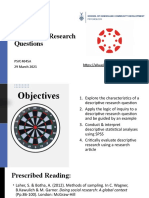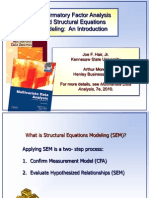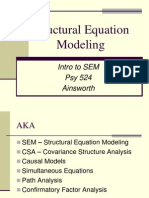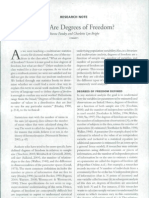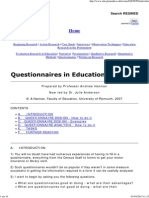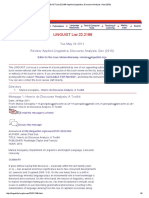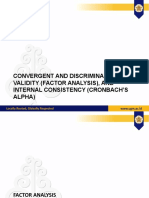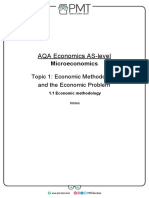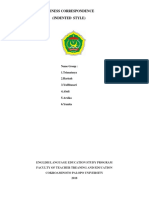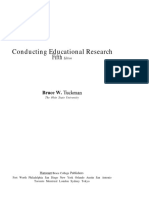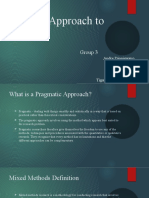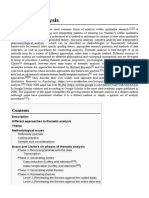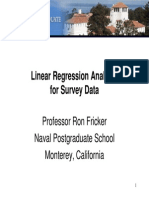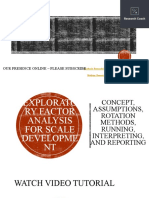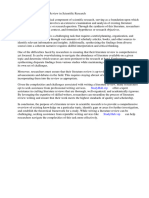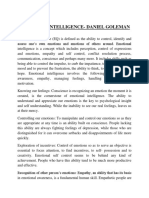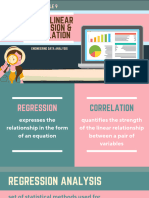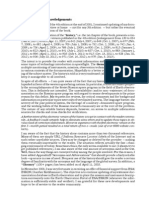FACTORANALYSIS
MTahir
�INTRODUCTION
Thefactoranalysistechniquereducesthelarge
numberofvariablesintofewunderlyingfactors
toexplainthevariabilityofthegroup
characteristics.
Theconceptusedinfactoranalysistechniqueis
toinvestigatetherelationshipamongthegroup
ofvariablesandsegregatethemindifferent
factorsonthebasisoftheirrelationship.Thus,
eachfactorconsistsofthosevariableswhichare
relatedamongthemselvesandexplainsome
portionofthegroupvariability
�EXPLORATORYVERSUS
CONFIRMATORYFACTORANALYSIS
Inexploratorystudy,wedonotknowanything
aboutthenumberoffactorstobeextracted,the
numberofvariablesincludedineachfactorand
percentageofvariabilityexplainedbythese
extractedfactors.
confirmativefactoranalysisisrequiredtotest
theexistingfactormodel
�KEYTERMS
Principalcomponentanalysis(PCA):itisusedto
reducethelargenumberofvariablesintosmaller
numberofprincipalcomponentsthatwillaccount
formostofthevarianceintheobservedvariables
Factorloading:itcanbedefinedasthe
correlationcoefficientbetweenthevariableand
factor
Communality:Itcanbedefinedasthesumofthe
squaredfactorloadingsofavariableinallthe
factors
�KEYTERMSCONTD
Eigenvalue:Itmeasuresthevarianceinallthe
variableswhichisaccountedforbythatfactor.
(Criteria>1)
ScreePlot:Itisagraphicalrepresentationofthe
factorsplottedalongXaxisagainsttheir
eigenvalues,ontheYaxis.
�STEPSINRUNNINGEXPLORATORY
FACTORANALYSIS
1. Computedescriptivestatisticsforallthe
variables
2. Preparecorrelationmatrix
3. ApplyKMOtesttochecktheadequacyofdata
forrunningfactoranalysis(>0.5)
�STEPSCONTD
4.ApplyBartlettstestofsphericity(Criteria=
shouldbe<0.01)
5.Obtaininitial(unrotated)andthenfinalsolution
byusingthevarimaxrotation(Criteria=Factor
loading>0.70)
6.NametheVariablesbasedonresearchers
understanding.
�ASSUMPTIONSINFACTOR
ANALYSIS
1.Alltheconstructswhichmeasurethe
conceptshavebeenincludedinthestudy.
2.Sufficientsamplesizehasbeentakenfor
factoranalysis.Normallysamplesizemust
beequalto520timesthenumberof
variablestakeninthestudy.
3.Nooutlierispresentinthedata.
4.Multicollinearityamongthevariables
doesnotexist.
�ASSUMPTONSCONTD
5.Homoscedasticitydoesnotexistbetweenthe
variablesbecausefactoranalysisisalinear
functionofmeasuredvariables.
6.Variablesshouldbelinearinnature.Nonlinear
variablesmayalsobeusedaftertransformingit
intolinearvariables.
7.Datausedinthefactoranalysisisbasedon
intervalscaleorratioscale.
�COMMANDINSPSS
AnalyzeDimensionReductionFactor
ChecktheoptionUnivariatedescriptiveand
ensurethattheoptionInitialSolutionis
checkedintheStatisticssectionbydefault.
ChecktheoptionCoefficients,Significance
levels,andKMOandBartlettstestof
sphericityinCorrelationMatrixsection.
InExtraction,checkScreeplot.
InRotationcheckVarimaxrotationoption.
�OUTPUT
Descriptivestatistics
Correlationmatrix
KMOandBartlettstest
Communalitiesofallthevariables
Totalvarianceexplained
Screeplot
Componentmatrix:unrotatedfactorsolution
Rotatedcomponentmatrix:varimaxrotated
solution
�SUMMARYOFCOMMANDS
(i)StartSPSSandpreparedatafilebydefiningthevariablesandtheirproperties
inVariableViewandtypingthedatacolumnwiseinDataView.
(ii)Inthedataview,followthebelowmentionedcommandsequenceforfactor
analysis:
Analyze!DimensionReduction!Factor
(iii)SelectallthevariablesfromleftpaneltotheVariablessectionoftheright
panel.
(iv)ClickthetagDescriptivesandchecktheoptionsUnivariatedescriptives,
InitialSolution,Coefficients,Significancelevels,andKMOand
Bartlettstestofsphericity.PressContinue.
(v)ClickthetagExtractionandthencheckScreeplot.Letotheroptions
remainasitisbydefault.PressContinue.
ClickthetagRotationandthencheckVarimaxrotationoption.Letother
optionremainsasitisbydefault.PressContinue.
(vii)ClickOKforoutput
�CONFIRMATORYFACTOR
ANALYSISUSES
Evaluationoftestinstruments
Constructvalidation
Convergentvalidity
Discriminantvalidity
Developmentandtestingofthemeasurement
modelforaSEM.
�ADVANTAGESOFCFA
Thefitofthemeasurementmodelcanbe
determinedbeforeestimatingtheSEMmodel.
InSEMmodelsyoucanestablishrelationships
amongvariablesadjustingformeasurement
error.
CFAcanbeusedtoanalyzemeanstructures.
�STEPSINCONFIRMATORYFACTOR
ANALYSIS
Step1=Definethefactormodel
Step2=Collectmeasurements
Step3=Obtainthecorrelationmatrix
Step4=Fitthemodeltothedata
Step5=Evaluatemodeladequacy
(InsignificantChisquare,Chisquare
value/df=<5,RMSEA<0.05,GFI>0.90,NFI>0.90,
)
Step6=Comparewithothermodels




